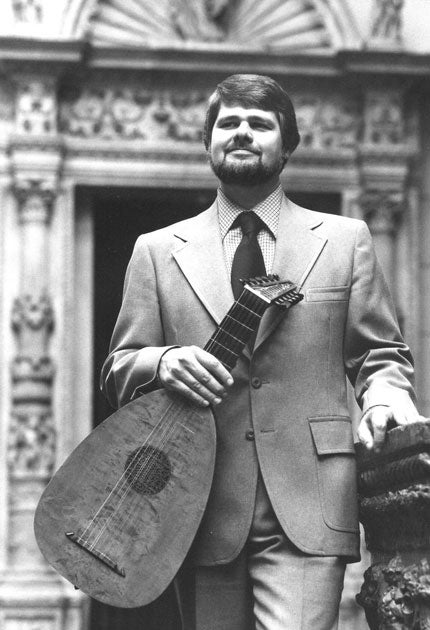James Tyler: Lutenist who helped lead the early-music revival of the 1960s

The 1960s was the decade when the early music group came of age, with historically authentic ensembles such as New York Pro Musica, Studio der Frühen Musik (Munich), and David Munrow's Early Music Consort of London reaching new levels of technical and musical excellence on period instruments. The lutenist James Tyler was a member of all three groups, during the early part of a career that was devoted to the historically accurate performance of music for plucked strings. His death has robbed the early music world of one of the finest, most knowledgeable, and most likeable exponents of those instruments.
James Tyler was born in 1940 in Hartford, Connecticut, and his father worked for Pratt-Whitney, the aircraft manufacturing company. Jim's first instruments were mandolin, tenor banjo, and the gut-strung finger-style banjo, which he studied (1954-58) with Walter Kaye Bauer.
Bauer gave him a rigorous musical training that stood him in good stead for his entire career, and Jim later observed that the Edwardian banjo technique he acquired then was remarkably similar to the historically authentic techniques that he later mastered on the lute (which he studied 1958-61 with Joseph Iadone) and the Renaissance guitar, but very different from the conventional Segovia-style classical guitar technique that many of his contemporaries were acquiring. His professional career began as a member of Noah Greenberg's New York Pro Musica (1963-66), after which he moved to Munich, before settling in London in 1969, where his excellence on the lute was soon recognised, and where he rapidly became a leading figure on the early music scene.
Tyler's enthusiasm for performance was extraordinary. Besides working closely with Munrow for several years, he recorded several ground-breaking albums of lute duets with Anthony Rooley, co-founded the Consort of Musicke, and toured with the Julian Bream Consort, before founding his own ensemble, the London Early Music Group in 1977. These activities involved an enormous amount of international travelling, and in every city he visited, he spent his spare hours in the manuscript sections of the great libraries, methodically acquiring a first-hand knowledge of the largely forgotten repertoires for Renaissance and Baroque plucked instruments, not just the lute, but also the guitar and mandolin.
This scholarship resulted in several books for Oxford University Press, the first of which, The Early Guitar:a history and a handbook (1980), drew attention to the long-neglected four-and-five-course guitar, explained how to play its vast repertoire of original music, and effectively kick-started interest in this pre-classical instrument. A later book, The Early Mandolin (1989), did something similar for the finger-style gut-string mandolin, while The Guitar and its Music: from the Renaissance to the Classical Era (2002) expanded his previous work on the guitar. It was my privilege to have been his co-author on both those later volumes.
In 1975, he formed the New Excelsior Talking Machine, a ragtime ensemble which featured his tenor banjo playing, and he performed on the same instrument (in full Edwardian dress) on BBC television's The Good Old Days. Such musical activities raised eyebrows among a few of his more straitlaced British colleagues, who seemed to regard his versatility as a sign of frivolousness, but Jim took all plucked instruments seriously, and demonstrated that the banjo, in the right hands, could be as subtle and sensitive as the lute. His formidable scholarship was always coupled to a keen practical interest in authentic methods of instrument construction, and in the physical limitations of the materials which musicians had used in earlier periods (such as the gut, brass and silk strings which lutenists and guitarists had relied upon for centuries, before the invention of nylon and tempered steel), and that combination of deep academic knowledge and hands-on practical expertise made him an ideal teacher.
The centre of gravity in his career shifted from performance to teaching in 1986, when he was offered theposition of director of the Early Music Performance Program at the University of Southern California. He and his American-born wife Joyce decided it was time to move back across the Atlantic, and once there, Jim's reputation inspired countless early music enthusiasts to move to Los Angeles to study with him. He officially retired in 2006, but continued to teach and inspire his many students and colleagues until his death.
My last meeting with Jim was a year ago, in a restaurant on Sunset Boulevard, where he reminisced abouthis early career in Germany and London, discussed some finer points of lute technique, and then told me about a recording he had made of the Vivaldi mandolin concerto – not for some arcane and erudite early music label, but for the part live-action, part-animated film Looney Tunes Back in Action (2003).
Far from considering such work to be beneath him, he had approached the recording with the same meticulous care that he devoted to every performance, had been accompanied by Hollywood's finest session musicians, and had relished the chance to bring authentic finger-style mandolin playing to a mass audience. A typically unpretentious approach from one of early music's most gifted, knowledgeable, and inspiring communicators.
James Henry Tyler, musician and writer: born Hartford, Connecticut 3 August 1940; married 1975 Joyce Geller; died Los Angeles, California 23 November 2010.
Subscribe to Independent Premium to bookmark this article
Want to bookmark your favourite articles and stories to read or reference later? Start your Independent Premium subscription today.

Join our commenting forum
Join thought-provoking conversations, follow other Independent readers and see their replies